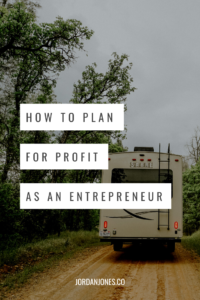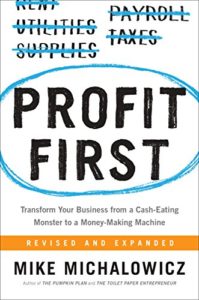One of the hardest parts about becoming my own boss and starting our own business was figuring out all of the logistics and money.
I joke that for all of my life I used to live by the “manual” of what people tell you to do (get good grades, go to a great school, get a good job, etc) and that I always kind of knew what I needed to do to make those things happen.
Well entrepreneurship was like jumping into the deep end with NO manual what-so-ever 😳
Our first year in business, we were living off of our savings account from our corporate jobs – we make just over $10k. Needless to say, we didn’t have a strategy for our money, let alone profit planning.
Fast forward to us *actually* making money in our business and we STILL didn’t have a plan. Yes, we finally had a separate business checking and savings account, but that was about it.
It’s embarrassing to think about now, but even when we were earning 6-figures from our business, we really didn’t have a plan for our money. We were saying yes to every project that came our way because we didn’t know how to project our income, and I always felt anxiety paying our business credit card bills because even though we could always pay in full, it felt like we didn’t have control over our money.
That all changed in 2018.
2018 was the first year we started planning for income and profit in a real way. In this post, I’m going to walk you through the exact steps we took to take control of our finances, change how we did accounting, and finally start paying ourselves consistently.
Why We Use Profit First Accounting
After reading Mike Michaelowicz’s The Pumpkin Plan, I was intrigued and inspired enough to read his money-focused book, Profit First.
Guys – it was a complete gamechanger.
The book will give you the kick in the pants you need to FINALLY take control of your money and stop living in this feast-or-famine cycle we can so easily fall into as entrepreneurs.
I really can’t recommend it enough. The steps I share here are taken from everything I’ve learned in Profit First (this is kind of like your cheat sheet), but reading the actual book and seeing how this process works for other businesses is insanely helpful!
Essentially, Mike lays out a plan for accounting that will help you:
- Actually make a profit in your business
- Pay yourself consistently even if your income fluctuates
- Plan for taxes (and have your business pay for them)
- Reduce your operating expenses
The best part is that you review and update your Profit First plan every quarter, so you’re constantly challenging yourself to do better (aka reducing operating expenses, taking more in owner’s compensation, profit, taxes, etc). We’ll go through this together next!
Setting Up Your Bank Accounts
So if you read the book, you’ll learn that Mike wants you to have a SEPARATE “profit” account at another bank so that you don’t touch that money – out of sight, out of mind.
I’ll walk you through the basic accounts you need and what has worked for us to keep it as simple as possible. Also, I’m just a straight-up rule keeper so if you tell me I can’t use my Profit account to pay for expenses, I won’t. Discipline is key here!
Note: I’ll be walking you through how we do this as self-employed entrepreneurs with no employees! Mike gives a TON of examples in his book depending on how big your business is and the needs you have.
Here are the basic accounts you’ll need to do Profit First account:
Profit
Probably no surprise here! Your Profit is your business profits, not what you pay yourself. You’ll only draw from this each quarter and the goal is to have enough money in your profit to have a financial runway should you ever need it unexpectedly. This will be a new account and it could be a savings account since you won’t draw from it often.
Operating Expenses
This will likely be the checking account you already have for your business. Odds are you already have automatic payments set up for different tools or systems you use, so it’s easiest to turn your current checking account into the operating expense account. From now on, any and all expenses will come from this account, including paying any bills.
Owner’s Compensation
Yay! You’re actually going to start paying yourself bi-monthly now. The Owner’s Compensation is the account you’ll pay yourself out of – but it’s not your personal checking account. I’ll explain the logistics below, but you’ll be transferring money IN to your Owner’s Comp account and then transferring OUT your salary to your personal account (there will likely be a difference in amount).
Taxes
No more tears during quarterly estimates or at the end of the year! 😅You’ll be planning for your taxes all year long and paying them right out of this business account.
Income
This account is where all of your revenue will be deposited into. Any checks, any credit card payments, and deposits you receive for your revenue will all be deposited into this account. This will be what you use to do your monthly tasks and it will be zeroed out each month. (Again, be sure you get the maintenance fees waived since this will always be going to “0” each month as you transfer the money earned into the other accounts!)
Pro tip: If this feels a little overwhelming, I totally get it. It took me two months to actually just walk into my bank and set these up – it just felt a little crazy! But setting them up is the hardest, most time-consuming part. It’s actually super easy to create new accounts with your bank, you just have to make sure you have them waive any maintenance fees (Yes, you can ask them to do that! If they don’t, find a new bank. We use TD Bank for our business accounts and never have a problem).
How to Do Your Monthly Profit First Tasks
In Profit First, Mike recommends doing your accounting on the 10th and 25th of each month, so I just set a recurring task in my Asana and on my calendar to make sure I do this those days every month. Makes it super easy to stay on top of!
Before you start with Profit First, you’ll need to determine your CAPS (Current Allocation Percentages) and your TAPS (Target Allocation Percentages) – aka figure out where you are NOW and what your goals are.
You can do the free instant Profit First assessment here!
Each month when it’s time for your Profit First date, you’ll do the following things:
- Look at the total in your Income, and figure out the amounts to transfer to each of your other accounts, depending on your TAPS.
- Ex: If you earned $5,000 for the first half of the month and you pay yourself 50% in Owner’s Compensation, you’ll transfer $2,500 into the Owner’s Comp account.
- Once you transfer the income and zero out that account, you can then pay any expenses out of your Operating Expenses account. This is a really clear indicator of if you’re spending more than you can afford! (I’ll share our personal results below… they shocked me)
- Next, I transfer my bi-monthly salary from our Owner’s Compensation into our personal account. So if you pay yourself $4,000/mo, you’d transfer $2,000 of the $2,500 above into the personal account. That $500 leftover stays in Owner’s Compensation. This method really helped me feel comfortable paying ourselves routinely when our income can easily fluctuate depending on clients and launches.
- This next step is personal, but if you practice tithing, we then transfer 10% of our income into our Giving account. This isn’t something Mike teaches, but it’s a personal priority of ours.
That’s it! You’ve now done your first Profit First day!
You’ll do those same things twice a month, every month.
Quarterly and Year-End Tasks and Review
Each quarter, you’ll want to review your current percentages and make any updates. For instance, did you find that you have plenty leftover in Operating Expenses to cover your costs? Perhaps you can lower that percentage and increase the amount you’re contributing to Tax or Owner’s Compensation.
Each quarter, you’ll also distribute profit to yourself (yay!). He recommends taking 50% of the Profit for yourself and keeping 50% in the Profit account as a reserve. If you have any debt, he then recommends putting 90% of your Profit to paying off debt, but he’s insistent that 10% is used for fun!
At the end of each year, you’ll pay the remaining taxes out of your Tax account. If you’re under, pull money from your Profit account to cover the rest of the taxes. If you’re over, move the remaining money in Taxes into your Profit account.
Phew! I know that sounds like a lot, but I promise you, this process has been a complete GAMECHANGER in our business! I can’t recommend it enough.
Our Profit First Results
Okay okay, I’ve mentioned this process changed our business quite a few times – but HOW?
When we finally started using Profit First, our assessment showed our CAPs to be the following:
- Profit: 0%
- Owner’s Compensation: 21.5% (we legit just took Owner’s Draws as needed to cover personal expenses, but we were NOT paying ourselves consistently)
- Tax: 0% (again, we just paid this out of our personal accounts as needed, but we weren’t actively planning for it)
- Operating Expenses: 78.5% – INSANE!
That assessment was embarrassing and a big eye-opener. We were spending WAY too much money running our business and not paying ourselves nearly enough.
Using Profit First kicked our butt into shape and made us take a hard look at how we ran our business. Our first quarter, we started with the following CAPS:
- Profit: 1%
- Owner’s Comp: 25%
- Tax: 5%
- Operating Expenses: 69%
It may not seem like a big difference, but Mike recommends starting with small increases/decreases so that you never need to move “backward”.
Well, his process WORKED. One year later, this is what our quarterly CAPS were:
- Profit: 4%
- Owner’s Compensation: 48%
- Tax: 8%
- Operating Expenses: 40%

In just one year of using Profit First, we doubled how much we were paying ourselves (and doing it consistently), and we cut our operating expenses in half. We also were finally planning for taxes in a way that made it easy to pay our quarterly estimates without fear or worry.
Hopefully, sharing our real messy numbers will inspire you to take action yourself and start using Profit First in your business!
If you do give it a try, I’d love to hear from you below! And if you have any questions, ask away in the comments below 👇


View comments
+ Leave a comment